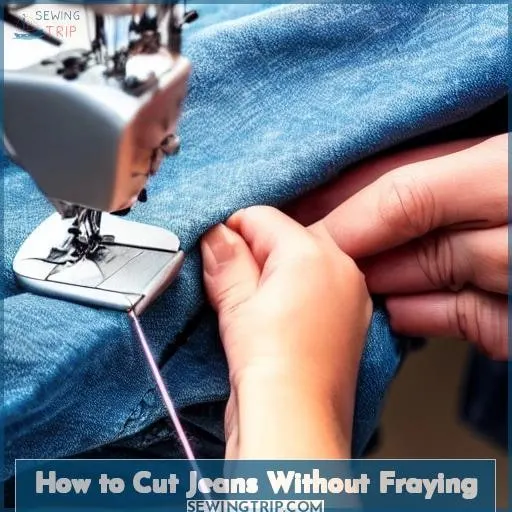This site is supported by our readers. We may earn a commission, at no cost to you, if you purchase through links.
Do you have a favourite pair of jeans that are starting to fray? You’re not alone. 30 million pairs of jeans are thrown away in the US every year due to fraying and other damage. But don’t worry – you can stop your beloved jeans from fraying and keep them looking their best!
Put on your creative hat – let’s get started! Here are some simple techniques you can use to repair rips and tears:
- Use an iron-on patch or fabric glue to patch the frayed area.
- Sew a patch onto the jeans to cover the frayed area.
- Apply a fabric sealant to the frayed area.
- Use fray check or fabric glue along the edges of the frayed area to stop it from spreading.
- Use a clear nail polish to seal the frayed edges.
By following these simple steps, you can keep your jeans looking their best and extend their life.
Table Of Contents
- Do Jeans Keep Fraying?
- How to Stop Frayed Jeans From Fraying
- Keep Denim From Fraying
- How to Stop Cut-off Shorts From Fraying
- Stop Jeans From Fraying in the Crotch
- Jeans Frayed on Side
- Jeans Frayed on the Bottom
- How to Stop Jeans From Fraying Without Sewing
- Can You Fix Frayed Jeans?
- Can You Hem Frayed Jeans?
- How to Cut Jeans Without Fraying
- Some Cutting Denim Tips and Tricks
- Frequently Asked Questions (FAQs)
- Conclusion
Do Jeans Keep Fraying?

Are your jeans fraying and ruining your look? Take action now to keep them looking their best! Hemming, mending techniques, storage solutions and DIY guides are great methods to prevent further fraying. Kamel Almani suggests using Fray Block on edges before sewing to create a stronger bond between material strands. Iron-On Patches are also great for repairing larger rips in denim – just make sure to follow instructions before ironing!
When washing jeans, opt for the delicate cycle with cold water, add some dryer balls if possible, then air dry flat on a surface indoors. This’ll help avoid unnecessary agitation, which could increase wear and tear over time. Use color preserving detergents like EcoClean for dark garments too!
By applying these maintenance methods, you’ll save yourself from costly repairs and prolong your jeans’ life span.
How to Stop Frayed Jeans From Fraying
You can easily stop frayed jeans from further fraying by using a few simple techniques. To start, use Fray Block at the edge of the fabric to prevent it from unraveling any further. Alternatively, sew an inside patch over larger rips or tears for extra security. For smaller rips and tears, sew a single line with denim thread. Make sure to use matching thread color to keep your jeans looking neat and stylish.
1 Use Fray Block
Are you struggling to keep your jeans from fraying? Try using Fray Block for a stronger bond between the material strands and prolong their life span!
Patch them with iron-on patches, wash them in a mesh bag on delicate cycle (with color preserving detergent), buy quality denim fabric when replacing old jeans. Wear clothing that protects against wear and tear such as aprons or overalls while working or storing properly.
Snip away any fraying threads around rips before sewing up repairs. Secure zippers and buttons before starting wash cycles to prevent further damage.
Use Fray Block as an added precautionary measure to keep those pesky little bits of frayed denim at bay!
2 Use an Inside Patch
For an extra layer of protection against fraying, you can patch the inside of your jeans with iron-on patches. This is a great option for those who don’t want visible mending on the outside of their pants or just want added reinforcement.
Choose a denim or iron-on patch that matches the color and weight of your jeans. Follow the instructions on the package to activate any adhesive backing before placing it over any weak areas where fraying has already begun. Position it carefully along seams and edges, using pins if necessary to keep everything in place while you sew around its perimeter with a needle from your sewing machine or by hand stitching for added durability.
When laundering jeans, use a mesh bag during the washing cycle and only wash when they’re visibly dirty or smelling bad. Soak them in cool soapy water for at least 15 minutes. Hang clothes after the wash, instead of using drying machines. Smooth out wrinkles and secure buttons and zippers before starting the laundry. Use sock clips to hold fray portions together.
When fading jeans, wash dark colored garments separately and use eco-friendly detergents. Avoid bleach products and preserve colors.
When mending jeans, snip away excess threads and frays. Turn jeans inside-out and tuck the legs into the waistband area. Trim patches into smaller shapes and position them across rips. Iron and stitch a zig-zag pattern and cut off any excess material. You can also use fray block or a denim patch. You’ll need a needle and sewing machine, as well as iron-on packaging.
3 Sew a Simple Single Line
To finish off the fraying protection process, use a simple single line of stitching to reinforce your jeans’ edges and seams. The rhythmic motion of the needle will provide extra security with each stitch, creating an image that stands out from ordinary denim wear.
To protect against further fraying, try using fray block on the edges before sewing or ironing patches in place. After securing all rips and tears with thread or patchwork, it’s time to sew the seams together for maximum durability and aesthetics.
With a nice stitch job following the seam lines, you can trust that no matter what wear habits you put on these jeans, they won’t start showing signs of frayed edges anytime soon!
4 Use Denim Thread
For maximum durability and aesthetics, stitch your jeans together using denim thread to create a distinct image that stands out from the rest. Have all the necessary materials, including iron-on patches and color-preserving laundry detergent, ready before beginning.
Patch seams on the ends of the rip with an iron-on patch, following the packaging instructions precisely for fray prevention. Then press hems with cold water before turning them up and stitching them in place with matching denim thread for added style points.
Double check your work has been done correctly so it lasts through any activities or washes while preserving its original shape.
Take extra care when laundering your jeans. Follow proper steps, such as washing on a delicate cycle in cool water using a mesh bag, which will protect against further fraying caused by abrasion during machine washing cycles.
Keep Denim From Fraying
If you want to keep your denim from fraying, look for higher quality materials. Ones made of heavier-weight fabrics and more durable construction. Wear good boots when wearing jeans; they help protect them from wear and tear. Avoid tight fitting jeans too; they stretch out quickly, fraying seams or hems sooner than expected. To further reinforce the inner thigh area, attach an ironed-on patch before washing or machine drying your denim. This gives additional protection against wear and tear over time.
1 Buy Higher Quality Denim Material
Investigate whether higher quality denim material can help extend the life of your jeans and reduce fraying over time. Select a good pair of boots made with higher quality of denim fabric to prevent fraying due to excessive wear-and-tear or loose seams. Tailor the hem properly before ironing it for improved seam strength and prevention against fray damage.
When washing jeans, use a mesh bag to protect them from becoming tangled in your laundry machine cycle; this will further aid in preventing any unnecessary tearing or wearing down at the seams. If an iron-on patch is required, read through its packaging instructions carefully regarding steam setting. Not all patches are designed for high heat applications, so always use caution when selecting materials meant specifically for clothing repairs such as these!
2 Wear a Good Pair of Boots
Invest in a quality pair of boots to wear with your jeans for maximum durability and longevity. Avoid unnecessary fraying by wearing the right type of boot; it’ll also protect them from scuffing or stretching out. Look for ones made from tough materials such as leather which won’t easily show signs of wear and tear. Opt for styles with closed laces so they stay secure when walking around all day. Ironing jeans before wearing them reduces wrinkles and maintains the original color. Wash them using eco-friendly digital technology to keep them looking new longer – use Blue Angel certified detergents whenever possible.
3 Don’t Wear Tight Jeans
To avoid fraying your jeans, be sure to wear them in a comfortable fit that’s not too tight. Tight jeans can cause excessive fabric stretching and pulling at the seams, leading to frayed threads over time. Wear longer jeans with some extra length so they don’t get caught or snagged on rough surfaces. That can also lead to premature fraying of the fabric. Consider using different fabrics for areas that may receive a lot of rough treatment, such as knees and pockets. These materials are more durable than denim and will help preserve its color, while still giving you a fashionable look with an intentional distressed/frayed effect.
Washing techniques, like pre-washing, handwashing or machine washing, should also be considered to prevent further damage from occurring due to frequent laundering cycles. Follow specific instructions included on labels for best results!
4 Reinforce the Inner Thigh
To reinforce your denim and keep it looking strong for longer, think of the inner thigh as a castle wall that needs extra protection. Patch seams with glue to strengthen them. Stitch edges together.
Use iron-on patches on larger rips or tears. Read the patch’s packaging before applying it.
For color preservation, use a blue angel certified dermatologically tested detergent when laundering jeans.
Long, narrow zigzag stitches along seam lines further reinforce the inner thigh area of your jean shorts or pants.
How to Stop Cut-off Shorts From Fraying
If you’re looking to make cut-off shorts from an old pair of jeans, you’ll want to ensure the edges don’t fray. Sewing a hem with matching thread color will prevent fraying, while using gold-colored threads for embellishment can give your shorts a stylish flair.
With just an hour or less spent on scissors and sewing machine work, you can easily keep your cut-offs intact and looking great!
2 Sew a Nice Stitch Job
With a few simple stitches, you can easily and stylishly reinforce your denim for years to come! The key to stopping fraying in its tracks is all about the sewing techniques you use. Start by using high-quality thread types like denim thread that will hold up against wear and tear. When hemming options arise, consider trying out different styles of hems such as a zig-zag stitch or an iron-on patch for added flair.
It’s important to keep fabric care in mind too – make sure your washer isn’t causing unnecessary damage with harsh cycles or detergents that aren’t gentle on fabrics like denim. And speaking of denim, remember there are many different styles out there so it’s worth experimenting with what works best for each pair of jeans before committing to any one technique!
If you’re not confident in your abilities yet, don’t hesitate to consult with a cleaning specialist who can offer guidance based on experience working specifically with this type of clothing item – they might have some great tips beyond just basic hemming tricks!
To help visualize these sewing techniques more clearly, check out the table below which outlines some common stitch jobs used when repairing rips:
| Stitch Type | Description |
|---|---|
| Overlapping Stitches | Sew 3 rows across rip edges |
| Zig-Zag Stitch | Provides extra support and flexibility |
| White Thread Looping | Create loops around fray edge & tie knots after each loop |
| By mastering these various stitching methods while keeping proper fabric care practices top-of-mind, you’ll be able maintain those perfect-fitting pairs time after time without worrying about unwanted fraying effects creeping up over time. |
3 Use Denim Thread
You can easily create a strong and stylish reinforced hem with the use of denim thread. This’ll let your cut-offs last longer while still looking sleek. Patching techniques, such as alternate materials for fray blocking or double stitching certain stitch patterns, will ensure no frayed strands appear on the biggest kinds of jeans.
Denim’s strength and durability make it ideal for shorts. It won’t tear quickly and is less likely to fray at the edges. Denim thread is designed specifically for this purpose – providing even stronger reinforcement than traditional stitches. It gives you the flexibility to adjust how tight or loose your seams are stitched together, ensuring both modesty and style.
Stop Jeans From Fraying in the Crotch
If you’re looking for ways to stop your jeans from fraying in the crotch, there are a few simple steps that can help. Reinforcing the fabric with iron-on patches or sewing stitches will help keep them intact.
Don’t wear overly tight jeans, as this could put extra strain on seams and cause further damage.
Applying fray block along edges is an effective way to protect against fraying and extend the life of your denim.
1 Reinforce the Fabric
Take your cut-offs to the next level with denim thread, giving you a stronger reinforcement that’ll have them looking as fashionable in summer as they were on the first day of winter! To prevent fraying at the edge of your cut-offs, reinforce the fabric by sewing a straight line along it using denim thread. This will ensure extra support for any potential wear and tear.
Be sure to follow proper washing instructions and finishing techniques for fabric care so your jeans stay intact. Consider ironing or steaming inside-out before wearing to avoid marks or stains caused by direct heat application on delicate fabrics such as denim types.
Handle large tubs carefully during laundry time. Wet jeans can become heavy and difficult to manage, and may cause more damage around edges where threads are separating from one another.
Reinforce the fabric using the methods mentioned above to avoid further unraveling due to friction between clothing items in the washer.
2 Don’t Wear Tight Jeans
Avoid wearing jeans that are overly tight; the constriction can cause additional wear and tear which will only exacerbate any fraying. Opt for a less snug fit so your jeans don’t become too stretched out or start to fray around the crotch area. Use denim glue, fabric stiffener or double stitch with a suitable stitch length for lower quality denims prone to fraying quickly. Steam iron inside-out and hitch at pants leg drag to make them last longer without worrying about fraying.
3 Use Fray Block
Easily protect your jeans from fraying with Fray Block — a stitch in time saves nine! Tired of constantly repairing and replacing your favorite pair of denim? Try using this clear liquid solution to stop fraying in its tracks. Apply it along the edge or hemline of your jeans to seal the fibers together. For an even stronger hold, consider iron-on patches or zig-zag stitching.
To help you choose which technique is best, check out this handy table:
| Method | Pros | Cons |
|---|---|---|
| Heat Sealing | Quick & easy | Risky without practice |
| Boiling Water | Cheap option | Requires constant supervision |
| Ironing Seams | Smoother look | Might leave permanent creases on fabric |
| Machine Stitching | Less visible than hand-stitching | No matter what method(s) you choose, follow the instructions carefully. This’ll ensure your jeans stay looking great for as long as possible, avoiding unnecessary wear and tear. Also, remember to wash them properly — machine-wash on delicate cycle with color-preserving laundry detergent, then air-dry instead of putting them in a dryer machine. Excess heat exposure can cause more fraying over time. |
Jeans Frayed on Side
If your jeans are frayed on the side, you can use a single line of stitching to keep them looking neat and tidy. To avoid further fraying in the inner thigh area or along pant leg, make sure to reinforce stitches with long threads. Pre-washing tips like using mesh bags and clips for open areas will also help prevent fabric from getting damaged during rough laundry cycles.
Use color-preserving detergents when washing dark-colored denim garments as they may fade over time without proper care. Ironing techniques such as steam settings turned off and iron-on patches should be used for larger rips, while needle and thread does well enough for smaller ones; trimming away extra threads afterwards is important too!
Following these steps should give you better results when it comes to keeping your jeans looking neat at all times!
Jeans Frayed on the Bottom
Experience the joy of creating your own stylish cut-offs by hemming and transforming those frayed jeans bottoms. To achieve a perfect fashion fringe, it’s all about selecting the right denim fabric and using smart methods to prevent further fraying.
One common method is sewing a quick hem with matching thread color for that professional look. Additionally, iron fusing patches on ends of rips provide extra support.
Kamel Almani, co-owner of WashyWash, suggests using dryer balls to keep wrinkles away when washing or drying clothes in order to stop edges from unraveling any further.
With just an hour (or less) spent with scissors and a sewing machine, you can create amazing cut-off jeans that’ll last through the summer season without losing its charm or modesty!
How to Stop Jeans From Fraying Without Sewing
If you want your jeans to look brand new and prevent fraying, there are a few easy steps you can take – no sewing required! Buy quality materials with design details that help minimize the chance of frays. Look for heavier material weights such as denim or canvas and consider investing in iron-on patches.
Wash them carefully according to the instructions on their tags. Opt for hand washing when possible, but machine washing is an option too – with cold water setting and low drying temperature settings.
Choose jeans that fit comfortably at home, rather than buying long length legs. These tend to fray easily over time due to excess motion while walking or sitting too much, without proper care.
Today, there’s a large selection of colors so it should be easier than ever before to find good fitting jeans regardless of skill level. Pick something unique from among all the biggest kinds available!
Can You Fix Frayed Jeans?
You can easily fix frayed jeans with a few simple steps! Prevent fabric damage – choose quality fabrics, avoid tight fits and store them properly when not wearing. Wear the right underwear underneath to prevent chafing.
Use fabric scissors to cut off any loose threads or trim away fraying edges close to the rip. If you’re feeling crafty, sew on iron-on patches over small rips in a zigzag stitch for extra support. For larger rips or tears, use white thread across edges – make sure it’s tightly knotted after each loop.
Hand-wash best, but if needed, machine-wash delicately with cold water and color-preserving detergent, then tumble dry low before air-drying thoroughly. This’ll ensure all parts stay intact without losing shape over time due to too much heat exposure.
With these tips in mind, you’ll have fixed frayed jean troubles in no time!
Can You Hem Frayed Jeans?
You can easily hem frayed jeans with a straight line of stitching and some matching thread. Denim is ideal since it’s strong and durable, but if you want boxers shorts or something stretchy, opt for another fabric. Sewing techniques are important: use quality control by sewing neat lines along edges to prevent further fraying. For added style, try gold-colored threads or iron-on patches per instructions on the packaging.
Measure all around each leg before cutting away excess material. Don’t pull or cut through the line of stitches when creating a quick hem effect.
Take care when washing: use mesh bags during machine wash cycles and air dry. This’ll help preserve color and prevent extra wear/tear from the machine’s spinning action. Smooth results will be yours!
How to Cut Jeans Without Fraying
Cutting jeans without fraying can be tricky. But with the right tools and techniques, you’ll have perfect cut-offs in no time.
Use sharp scissors for clean edges that won’t fray easily.
Use Fray Block on raw edges before washing and drying them off.
With these tips, you’re ready to create stylish denim shorts without any fuss!
1 Use Sharp Scissors
You can ensure a precise, fraying-free cut by using sharp scissors when cutting your jeans. Sewing techniques such as regular stitch and extra threads in the hemline will help. Quality fabrics like denim require special care and attention. To prevent frays, use fray block options such as an iron-on patch. It comes with its own packaging instructions for easy application of pea-sized amount of laundry detergent along edges before ironing it on the fabric.
With these helpful tips in mind, and careful cutting techniques, you’ll get perfect results every time!
2 Use Fray Block
To ensure a precise, fraying-free cut on your jeans, use an iron-on patch and a pea-sized amount of laundry detergent for added protection. Tape hemming is also important to prevent unraveling at the edges. Double stitch along the edge with matching thread color before distressing the denim by pulling out jean threads, combing them out and trimming them down. Iron all around each leg, including the bottom hems, if needed, to make sure they don’t fray over time.
Before machine washing jeans, turn them inside-out in a cold water cycle using the right underwear – for men, boxer shorts – and clip ripped portions together with sock clips, or secure zippers and buttons, so everything stays in place.
After removing from the wash, follow the manufacturer instructions found on the iron-on patches packaging, then position the patches on the ends of the rip to provide extra support. Sew a few rows of overlapping stitches for added sturdiness, making sure to tie a knot after each loop, which will help hold the fabric together longer. Air dry as recommended.
Some Cutting Denim Tips and Tricks
With a few simple tricks, you can create clean denim cuts that will last for seasons to come – like constructing an invisible wall of protection around your jeans. To start, the most important step is ensuring a straight fabric grain before cutting and sewing the hemline.
Denim needs extra care when it comes to hemming techniques. A quick solution is using a single line of shortened straight stitch with matching thread color; however, this method requires frequent repairs due to its low durability against wear and tear.
For more secure hems, opt for double stitching or use a pair of sock clips before machine washing them. Invest in DIY jeans fixes, such as iron-on patch packages with detailed instructions for application and finishing off rips and tears.
Style your jeans with gold-colored threads along hemlines or create frayed edges effects with jeans care kits available at stores near you – giving your jeans the special attention they deserve!
Frequently Asked Questions (FAQs)
How long should jeans be soaked in cool, soapy water for hand washing?
Soaking your jeans in cool, soapy water can help stop fraying by gently loosening wandering threads and protecting the fabric from further damage. Aim for at least 15 minutes.
Depending on the tap water temperature, use warm or cool for a more comfortable soak. Then rinse off with clean water and air-dry them flat.
If laundering techniques fail, consider an iron-on patch. Check the packaging instructions to make sure all edges are secured together.
What kind of thread should be used for sewing a hem?
When transforming old jeans to summer wear, sewing a hem is essential to prevent frays. Denim thread should be used to reinforce and keep the shorts looking their best. For added style, use gold-colored threads or fancy stitches around the edges. When measuring cut-offs, leave yourself a couple of extra inches to allow for fraying after washing and drying. Iron on patches are also an option; just follow the instructions on their packaging before applying them with an iron set to no steam.
How can patches be applied to jeans to repair rips?
Repairing your jeans has never been easier with iron-on patches. Clip the ripped portions, secure zippers and buttons, then wash them in a delicate cycle with color preserving detergent. After drying, turn the jeans right-side out. Tuck legs into waistband area, then position patches on ends of your tear for extra support. Trim iron-on patch’s packaging if necessary. Use an iron (no steam setting) or sewing machine to sew over patches for sturdiness. Trim any fraying threads close to edge of denim with fabric scissors for a professional finish – much better than dyeing!
Is it possible to machine wash jeans without them fraying?
Want to know if it is possible to machine wash jeans without them fraying? With the right washing tips and fabric quality, you can wear your favorite pair of jeans for longer.
Make sure to carefully reinforce techniques such as using a mesh bag when machine washing, iron-on patches with exact match thread color and following recommended instructions on the patch’s packaging. If done correctly, these will help stop any fraying that might occur in your denim garments due to excessive wear or laundering.
But there’s an even better way than this first option: consider handwashing instead! Be sure to follow laundry guidelines like soaking for 15 minutes before rinsing off in cool water and air drying afterwards – this helps preserve the material’s durability much better!
Is there an alternative to sewing to stop jeans from fraying?
Avoiding the tedious process of sewing can be a challenge when trying to repurpose ragged jeans into different styles. But there are alternatives that don’t involve stitching. Heat sealing is one option for hemming jeans, without needing to sew double stitches or iron on patches per the instructions from its packaging. This is a common situation with clothing items such as denim. Avoiding fraying at the edges requires extra attention and care, to prevent it happening again in future laundry cycles.
Conclusion
You’ve now got the know-how to stop your jeans from fraying. Patch up the fabric. Reinforce the inner thigh. Sew a nice stitch job. That way your jeans will last for years.
With a bit of effort and the right materials, you can make sure your jeans stay in top shape and look great. Plus, you’ll save time and money by doing it yourself. And with the right techniques, you can make sure your jeans look like new for years to come.
















